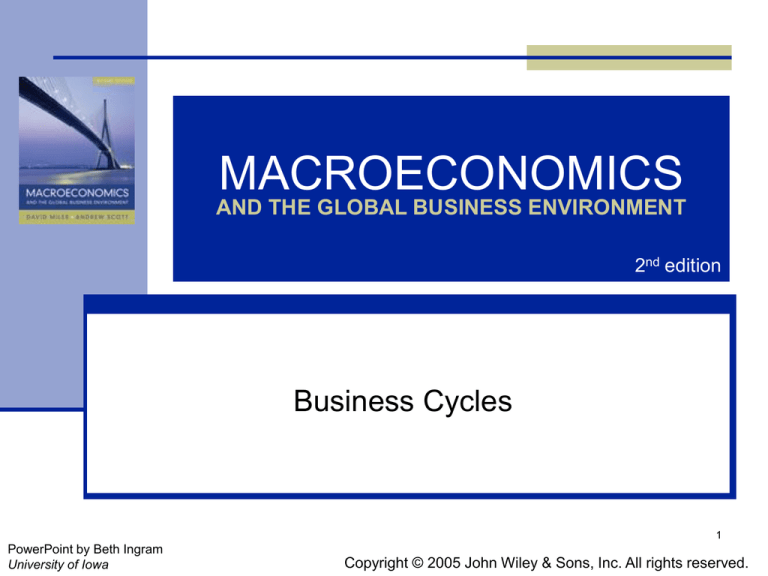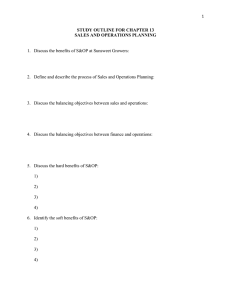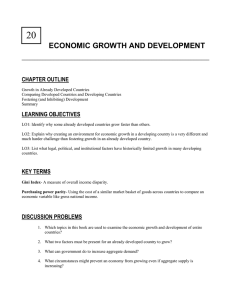
MACROECONOMICS
AND THE GLOBAL BUSINESS ENVIRONMENT
2nd edition
Business Cycles
1
PowerPoint by Beth Ingram
University of Iowa
Copyright © 2005 John Wiley & Sons, Inc. All rights reserved.
14-2
Key Concepts
Business Cycle characterization
Recessions and Depressions
Frisch-Slutsky Paradigm
Real Business Cycle Theory
Keynesian Theory
14-3
Business Cycle
Deviation from trend growth (i.e. fluctuations
in GDP around its trend)
Business Cycle
10500.0
8500.0
7500.0
6500.0
5500.0
4500.0
3500.0
2500.0
Potential Real GDP
Actual Real GDP
Jan-03
Jan-01
Jan-99
Jan-97
Jan-95
Jan-93
Jan-91
Jan-89
Jan-87
Jan-85
Jan-83
Jan-81
Jan-79
Jan-77
Jan-75
Jan-73
Jan-71
Jan-69
Jan-67
Jan-65
Jan-63
Jan-61
Jan-59
Jan-57
Jan-55
Jan-53
Jan-51
1500.0
Jan-49
Billions of 2000 Dollars
9500.0
14-4
Business Cycle
Trend GDP: for a given level of capital, labor, and
technology a certain amount of GDP can be
sustainably produced
Above trend: labor and/or capital being more
intensively used…unsustainable
labor must eventually rest or be paid premium (e.g.
overtime)
capital wears out and breaks down
Below trend: labor and/or capital not being fully
used.
eventually employ more capital and/or labor
14-5
Business Cycle
Output Gap: difference between actual and
potential (trend) GDP
Positive output gap: excess demand =>
upward price pressures
Negative output gap: excess supply (capacity)
=> downward price pressure
Note: you can have negative output gap and
positive growth => “growth recession”
n8
Ja 0
nJa 81
n8
Ja 2
n8
Ja 3
n8
Ja 4
n8
Ja 5
n8
Ja 6
n8
Ja 7
n8
Ja 8
n8
Ja 9
n9
Ja 0
nJa 91
n9
Ja 2
n9
Ja 3
n9
Ja 4
n9
Ja 5
n9
Ja 6
n9
Ja 7
n9
Ja 8
n9
Ja 9
n0
Ja 0
nJa 01
n0
Ja 2
n0
Ja 3
n04
Ja
Percent Deviation from Potential Growth
14-6
Business Cycle
U.S. Output Gap
4.00%
2.00%
0.00%
-2.00%
-4.00%
-6.00%
-8.00%
-10.00%
14-7
Stages of the Business Cycle
14-8
Stages of the Business Cycle
There are expansions and contractions
Aggregate economic activity declines in a contraction or
recession until it reaches a trough
Informal recession definition: 2 consecutive quarters or
negative GDP growth
Then activity increases in an expansion or boom until it
reaches a peak
A particularly severe recession is called a depression
The sequence from one peak to the next, or from one
trough to the next, is a business cycle
Peaks and troughs are turning points
Popular saying: “Recession is when someone you know
becomes unemployed; a depression is when you
become unemployed.”
350
300
250
Billions of 1972 Dollars
14-9
Business Cycle Example
The U.S. Great Depression
500
450
400
200
150
100
2
94
-1
ar
M 941
-1
ar
M 940
-1
ar
M 939
-1
ar
M 938
-1
ar
M 937
-1
ar
M 936
-1
ar
M 935
-1
ar
M 934
-1
ar
M 933
-1
ar
M 932
-1
ar
M 931
-1
ar
M 930
-1
ar
M 9 29
-1
ar
M 9 28
-1
ar
M 9 27
-1
ar
M 9 26
-1
ar
M 9 25
-1
ar
M 9 24
-1
ar
M 9 23
-1
ar
M 9 22
-1
ar
M
Linear (1922-1929 Trend)
Real GDP
14-10
Business Cycle Example
Economic Activity
United States
United Kingdom
Germany
France
Italy
Japan
Spain
Canada
Netherlands
Switzerland
Sweden
Australia
Denmark
Norway
Finland
Portugal
Share of World
GDP
(1931, Percent)
42.4
13.1
9.5
7.9
5.4
5.1
4.2
2.5
2.1
2
1.6
1.4
1.1
0.9
0.5
0.4
Peak
1929
1930
1928
1932
1928
1930
1929
1929
1930
1930
1930
1926
1930
1930
1928
1935
Trough
1933
1931
1932
1935
1933
1933
1931
1933
1934
1932
1933
1931
1932
1931
1931
1936
GDP Loss
(Percent)
-29.4
-0.5
-26.3
-10.4
-13.7
-14.9
-6.3
-29.7
-14.2
-6.5
-12.1
-24.9
-4.4
-8.0
-7.2
-0.7
14-11
Co-movement Across World
Real GDP
7
5
4
3
2
1
80
19
81
19
82
19
83
19
84
19
85
19
86
19
87
19
88
19
89
19
90
19
91
19
92
19
93
19
94
19
95
19
96
19
97
19
98
19
99
20
00
20
01
20
02
20
03
20
04
20
05
0
19
Annual Percent Growth
6
Advanced economies
Other emerging market and developing countries
World (All WEO countries)
14-12
The Changing U.S. Business Cycle?
14-13
Business Cycle Paradigm
Impulse/Shock
Propagation
Business Cycle
14-14
Business Cycle Paradigm
Shocks
monetary and fiscal shocks
consumption and investment shocks
technology shocks
external shocks: (1) exchange rate shock
(2) terms of trade shocks
financial system shock
14-15
Fluctuations
Increase in aggregate demand
Increase in C, I, G, NX
Increases prices and output
Increase in aggregate supply
Increase in labor, capital, TFP
Decreases prices and increases output
14-16
Aggregate Demand Aggregate Supply Model
Aggregate Demand Curve
Inverse relationship between price level and real
output: downward slopping
Real Balance Effect
Interest Rate Effect
Exchange Rate Effect
Short Run Aggregate Supply Curve
Positive relationship between price level and real
output: upward slopping
sticky input prices, sticky output prices, misperceptions
Long Run Aggregate Supply Curve
Real output independent of price level: vertical
Fundamentals—resources, productivity, trade—only
matter
14-17
Real Business Cycle Theory
Both growth and business cycles are caused
by aggregate supply shocks
Business cycles are outcome of optimizing
market mechanism
aggregate demand is endogenous
No role for government in changing the
nature of business cycles
14-18
Keynesian View
Prices and wages may be sticky … may not
adjust to equilibrate markets
Conduct countercyclical aggregate demand
management
Business cycle largely the result of
destabilizing movement in aggregate demand
New Keynesians also acknowledge aggregate
supply shocks matter
Government must step in to shore up
aggregate demand … policy can alter the
business cycle.





